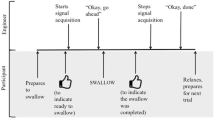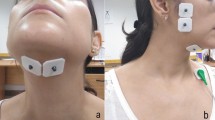Abstract
Surface electromyography (sEMG) is used as an adjuvant to dysphagia therapy to demonstrate the activity of submental muscles during swallowing exercises. Mechanomyography (MMG) has been suggested as a potential superior alternative to sEMG; however, this advantage is not confirmed for signal acquired from submental muscles. This study compared the signal-to-noise ratio (SNR) obtained from sEMG and MMG sensors during swallowing tasks, in healthy participants and those with a history of head and neck cancer (HNC), a population with altered anatomy and a high incidence of dysphagia. Twenty-two healthy adults and 10 adults with a history of HNC participated in this study. sEMG and MMG signals were acquired during dry, thin liquid, effortful, and Mendelsohn maneuver swallows. SNR was compared between the two sensors using repeated measures ANOVAs and subsequent planned pairwise comparisons. Test–retest measures were collected on 20 % of participants. In healthy participants, MMG SNR was higher than that of sEMG for dry [t(21) = −3.02, p = 0.007] and thin liquid swallows [t(21) = −4.24, p < 0.001]. Although a significant difference for sensor was found in HNC participants F(1,9) = 5.54, p = 0.043, planned pairwise comparisons by task revealed no statistically significant difference between the two sensors. sEMG also showed much better test–retest reliability than MMG. Biofeedback provided as an adjuvant to dysphagia therapy in patients with HNC should employ sEMG technology, as this sensor type yielded better SNR and overall test–retest reliability. Poor MMG test–retest reliability was noted in both healthy and HNC participants and may have been related to differences in sensor application.







Similar content being viewed by others
References
Langerman A, MacCracken E, Kasza K, Haraf DJ, Vokes EE, Stenson KM. Aspiration in CRT patients with HNC. Arch Otolaryngol Head Neck Surg. 2007;133:1289–95.
Hutcheson KA, Lewin JS, Barringer DA, Lisec A, Gunn GB, Moore MW, Holsinger FC. Late dysphagia after radiotherapy-based treatment of head and neck cancer. Cancer. 2012;118:5793–9.
Shaw SM, Martino R. The normal swallow: muscular and neurophysiological control. Otolaryngol Clin North Am. 2013;46:937–56.
Hind JA, Nicosia MA, Roecker EB, Carnes ML, Robbins J. Comparison of effortful and noneffortful swallows in healthy middle-aged and older adults. Arch Phys Med Rehabil. 2001;82:1661–5.
Lazarus C, Logemann JA, Song CW, Rademaker AW, Kahrilas PJ. Effects of voluntary maneuvers on tongue base function for swallowing. Folia Phoniatr Logop. 2002;54:171–6.
Bryant M. Biofeedback in the treatment of a selected dysphagic patient. Dysphagia. 1991;6:140–4.
Crary MA, Carnaby Mann GD, Groher ME, Helseth E. Functional benefits of dysphagia therapy using adjunctive sEMG biofeedback. Dysphagia. 2004;19:160–4.
Wheeler-Hegland K, Rosenbek JC, Sapienza CM. Submental sEMG and hyoid movement during Mendelsohn maneuver, effortful swallow, and expiratory muscle strength training. J Speech Lang Hear Res. 2008;51:1072–87.
Azola AM, Greene LR, Taylor-Kamara I, Macrae P, Anderson C, Humbert IA. The relationship between submental surface electromyography and hyo-laryngeal kinematic measures of Mendelsohn maneuver duration. J Speech Lang Hear Res. 2015;58:1627–36.
Reaz MB, Hussain MS, Mohd-Yasin F. Techniques of EMG signal analysis: detection, processing, classification and applications. Biol Proced Online. 2006;8:11–35.
Stepp CE. Tutorial: surface electromyography for speech and swallowing systems: measurement, analysis, and interpretation. J Speech Lang Hear Res. 2012;55:1232–46.
Hermens HJ, Freriks B, Disselhorst-Klug C, Rau G. Development of recommendations for SEMG sensors and sensor placement procedures. J Electromyogr Kinesiol. 2000;10:361–74.
Vigreux B, Cnockaert JC, Pertuzon E. Factors influencing quantified surface EMGs. Eur J Appl Physiol. 1979;41:119–29.
Brown CC. Reliability of electromyography detection systems for the pelvic floor muscles. School of Rehabilitation Therapy. Kingston: Queen’s University; 2007.
Islam MA, Sundaraj K, Ahmad RB, Sundaraj S, Ahamed NU, Ali MA. Cross-talk in mechanomyographic signals from the forearm muscles during sub-maximal to maximal isometric grip force. PLoS one. 2014;9:e96628.
Posatskiy AO.Design and evaluation of pressure-based sensors for mechanomyography: an investigation of chamber geometry and motion artefact.: Mechanical and Industrial Engineering, in collaboration with the Institute of Biomaterials and Biomedical Engineering: University of Toronto, 2011.
Silva S, Chau T. A Mathematical model for source separation of MMG signals recorded with a coupled microphone-accelerometer sensor pair. IEEE Trans Biomed Eng. 2005;52:1493–501.
Posatskiy AO, Chau T. Design and evaluation of a novel microphone-based mechanomyography sensor with cylindrical and conical acoustic chambers. Med Eng Phys. 2012;34:1184–90.
Mohamed Irfan MR, Sudharsan N, Santhanakrishnan S, Geethanjali B. A comparative study of EMG and MMG signals for practical applications. International conference on signal, image processing and applications with workshop of ICEEA 2011.
Lee J, Chau T, Steele CM. Effects of age and stimulus on submental mechanomyography signals during swallowing. Dysphagia. 2009;24:265–73.
Roy SH, De Luca G, Cheng MS, Johansson A, Gilmore LD, De Luca CJ. Electro-mechanical stability of surface EMG sensors. Med Bio Eng Comput. 2007;45:447–57.
Lee J, Steele CM, Chau T. Swallow segmentation with artificial neural networks and multi-sensor fusion. Med Eng Phys. 2009;31:1049–55.
Silva J, Chau T. Coupled microphone-accelerometer sensor pair for dynamic noise reduction in MMG signal recording. Electron Lett. 2003;39:1496.
Posatskiy AO, Chau T. The effects of motion artifact on mechanomyography: a comparative study of microphones and accelerometers. J Electromyogr Kinesiol. 2012;22:320–4.
Seikaly H, Jha N, McGaw T, Coulter L, Liu R, Oldring D. Submandibular gland transfer: a new method of preventing radiation-induced xerostomia. Laryngoscope. 2001;111:347–52.
Beck TW, Housh TJ, Cramer JT, Weir JP, Johnson GO, Coburn JW, Malek MH, Mielke M. Mechanomyographic amplitude and frequency responses during dynamic muscle actions: a comprehensive review. Biomed Eng Online. 2005;4:67.
Jaskolska A, Brzenczek W, Kisiel-Sajewicz K, Kawczynski A, Marusiak J, Jaskolski A. The effect of skinfold on frequency of human muscle mechanomyogram. J Electromyogr Kinesiol. 2004;14:217–25.
Valouchova P, Lewit K. Surface electromyography of abdominal and back muscles in patients with active scars. J Bodyw Mov Ther. 2009;13:262–7.
Crary MA, Baldwin BO. Surface electromyographic characteristics of swallowing in dysphagia secondary to brainstem stroke. Dysphagia. 1997;12:180–7.
De-Ary-Pires B, Ary-Pires R, Pires-Neto MA. The human digastric muscle: patterns and variations with clinical and surgical correlations. Ann Anat. 2003;185:471–9.
Basmajian JV, De Luca CJ. Muscles alive: their functions revealed by electromyography. 2nd ed. Baltimore: Williams & Wilkins; 1985.
Petitjean M, Maton B, Cnockaert J-C. Evaluation of human dynamic contraction by phonomyography. Am Physiol Soc. 1992;73:2567–73.
Ibitoye MO, Hamzaid NA, Zuniga JM, Hasnan N, Wahab AK. Mechanomyographic parameter extraction methods: an appraisal for clinical applications. Sensors. 2014;14:22940–70.
Al-Mulla MR, Sepulveda F, Colley M. A review of non-invasive techniques to detect and predict localised muscle fatigue. Sensors. 2011;11:3545–94.
Nonaka H, Mita K, Akataki K, Watakabe M, Itoh Y. Sex differences in mechanomyographic responses to voluntary isometric contractions. Med Sci Sports Exerc. 2006;38:1311–6.
Lazarus C. Dysphagia Secondary to the Effects of Chemotherapy and Radiotherapy. In: Shaker R, Belafsky PC, Postma GN, Easterling C, editors. Principles of deglutition: a multidisciplinary text for swallowing and its disorders. New York: Springer; 2013. p. 431–43.
McCabe D, Ashford J, Wheeler-Hegland K, Frymark T, Mullen R, Musson N, Hammond CS, Schooling T. Evidence-based systematic review: oropharyngeal dysphagia behavioral treatments. Part IV—Impact of dysphagia treatment on individuals’ postcancer treatments. J Rehabil Res Dev. 2009;46:205.
Russell JA, Connor NP. Effects of age and radiation treatment on function of extrinsic tongue muscles. Radiother Oncol. 2014;9:1–15.
Zaheer F, Roy SH, De Luca CJ. Preferred sensor sites for surface EMG signal decomposition. Physiol Meas. 2012;33:195–206.
Holobar A, Zazula D. Correlation-based decomposition of surface electromyopgrams at low contraction forces. Med Biol Eng Comput. 2004;42:487–95.
Evetovich TK, Housh TJ, Stout JR, Johnson GO, Smith DR, Ebersole KT. Mechanomyographic responses to concentric isokinetic muscle contractions. Eur J Appl Physiol. 1997;75:166–9.
Cramer JT, Housh TJ, Johnson GO, Ebersole KT, Perry SR, Bull AJ. Mechanomyographic and electromyographic responses of the superficial muscles of the quadriceps femoris during maximal, concentric isokinetic muscle actions. Isokinet Exerc Sci. 2000;8:109–17.
Smith DB, Housh TJ, Stout JR, Johnson GO, Evetovich TK, Ebersole KT. Mechanomyographic responses to maximal eccentric isokinetic muscle actions. Am Physiol Soc. 1997;82:1003–7.
Herda TJ, Ryan ED, Beck TW, Costa PB, DeFreitas JM, Stout JR, Cramer JT. Reliability of mechanomyographic amplitude and mean power frequency during isometric step and ramp muscle actions. J Neurosci Method. 2008;171:104–9.
Woodward R, Shefelbine S, Vaidyanathan R. Pervasive motion tracking and muscle activity monitor. Computer-based medical systems (CBMS), 2014 IEEE 27th international symposium on, 2014, pp 421–426.
Vaiman M, Eviatar E, Segal S. Evaluation of normal deglutition with the help of rectified surface electromyography records. Dysphagia. 2004;19:125–32.
Funding
This work was supported by Alberta Cancer Foundation Transformative Program Grant (26355); Alberta Innovate – Health Solutions (AIHS) Clinician Fellowship (#201400350); Natural Sciences and Engineering Research Council (NSERC) and industrial and government partners, through the Healthcare Support through Information Technology Enhancements (hSITE) Strategic Research Network (22143).
Author information
Authors and Affiliations
Corresponding author
Ethics declarations
Conflict of Interest
The authors Gabriela Constantinescu, Dylan Scott, Ben King, and Jana Rieger are inventors listed on a patent for the mobile swallowing therapy device. The patent application was made through TEC Edmonton Office, University of Alberta (file number: 2014015. No commercial interest has been shown at this stage).
Rights and permissions
About this article
Cite this article
Constantinescu, G., Hodgetts, W., Scott, D. et al. Electromyography and Mechanomyography Signals During Swallowing in Healthy Adults and Head and Neck Cancer Survivors. Dysphagia 32, 90–103 (2017). https://doi.org/10.1007/s00455-016-9742-6
Received:
Accepted:
Published:
Issue Date:
DOI: https://doi.org/10.1007/s00455-016-9742-6




